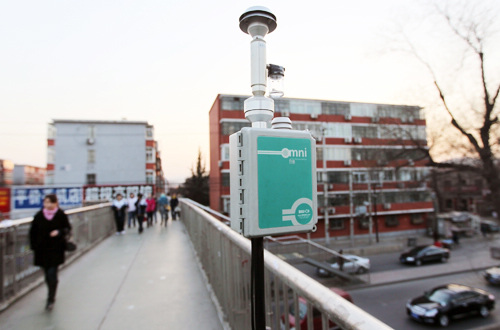|
 |
|
REAL-TIME MONITORING: A device for collecting particles in the air is in operation on a footbridge in Beijing's Haidian District (CFP) |
When the BMEPB evaluates Beijing's air conditions, Du said it gathers descriptive statistics from 27 major monitoring stations scattered throughout the city and this amounts to a more scientifically representative sample.
"In addition to the major stations, which monitor pollutants such as nitric oxide, sulfur dioxide, carbon monoxide and PM10, the bureau also has several experimental sub-stations located along major traffic arteries citywide that gather other data, such as the impact of car exhaust fumes and PM2.5," said Li Yunting, an engineer with the National Environmental Monitoring Center.
A press officer with the U.S. embassy in Beijing also acknowledged that the air-quality monitoring system used by the embassy differs from that used by the BMEPB in terms of its purpose and area coverage, so figures from the two sources have no common basis of comparison.
Facing accusations of underestimating air pollution in the capital, authorities in Beijing have begun to consider improving the way they measure air quality.
"The BMEPB applies the current national standard, which is being amended. Technically we are ready to adopt the PM2.5 standard," Du said.
China adopted the PM10 standard in 1995 that targets inhalable coarse particles between 2.5 and 10 microns in diameter. It was in 1996 that the BMEPB changed their measuring standards from PM100 to PM10.
"Currently, coarse particles are the focus of air-quality monitoring in China. Just like removing stones before clearing dust on a road, we need to first deal with larger particles before handling the smaller ones," Du said.
While the concentration of coarse particles in Beijing's air has decreased, the city's concentration of fine particles regularly exceeds safe levels.
"Fine particles are far more dangerous to human health and may cause cardiac and respiratory diseases as these small particles can be inhaled into the respiratory system, while coarser particles are blocked by the nostrils," said Pan Xiaochuan, a professor at the School of Public Health of Peking University.
Pan said that adopting the PM2.5 measurement to check air quality is a worldwide trend. "It is only a matter of time before Beijing follows suit," he said.
According to Wei Qiang, another engineer with the National Environmental Monitoring Center, the center has established monitoring stations that analyze Beijing's pollutant intensity for PM2.5 and even PM1. "The data will be released in the future, when the city adopts the PM2.5 standard," Wei said.
Early in 2007, the National Environmental Monitoring Center announced that it had accumulated some experience of PM2.5 monitoring by carrying out haze monitoring pilot programs in Tianjin, Shanghai and Chongqing municipalities, Guangzhou and Shenzhen in Guangdong Province and Nanjing in Jiangsu Province.
On November 1, the Ministry of Environmental Protection (MEP) implemented a regulatory document in which it set the standard for measuring PM2.5 for the first time.
However, experts also warned that many Chinese cities would have major difficulties in meeting the PM2.5 standard if it were adopted.
Pan said it would be difficult to ensure the standards are reliable and effective and to decide whether the PM2.5 standards should be based on number concentration or mass concentration.
"The MEP has considered adding PM2.5 into the national air quality standards for many years, but hasn't done so. Decisions such as these may be the reason," he said.
However Pan also expected that revised standards containing PM2.5 would be introduced within the next five years. In September Zhou Jian, Vice Minister of Environmental Protection, told a conference that China will re-evaluate and revise a series of environmental quality standards over the next five years.
Du admitted that there was room for improvement in the BMEPB's air-quality data release.
"We haven't done enough, or done it fast enough, in terms of educating people about air-quality monitoring," Du said in a micro-blog posting on November 1. "Many people have no idea what we are doing because we haven't provided an information service that is user-friendly enough. We have put out a lot of science jargon but never explained what it meant."
Beijing has undertaken a massive project to clean up its air since 2008.
Measures taken include moving polluting enterprises out of the city, getting residents in the old city quarter to switch from coal-fired to electric heating and expanding public transportation.
As a result, Beijing's air quality has gradually been improving, the BMEPB said in a statement on November 6.
According to the statement, Beijing had 63 days of excellent air quality in the first 10 months of this year, 12 days more than during the same period in 2008.
Additionally, the API on 239 days, so far, this year has been below 100, indicating good air quality.
The statement said the dense fog that blanketed the city was to blame for the nine days the city failed to reach the national blue sky standard in October. A similar situation occurred over the same period of 2008 and 2010, it added.
In April, the Beijing Municipal Government launched a five-year action plan to improve the environment by phasing out coal-fired boilers, saying excellent or good air conditions are expected for 80 percent of the days in the year by 2015. | 